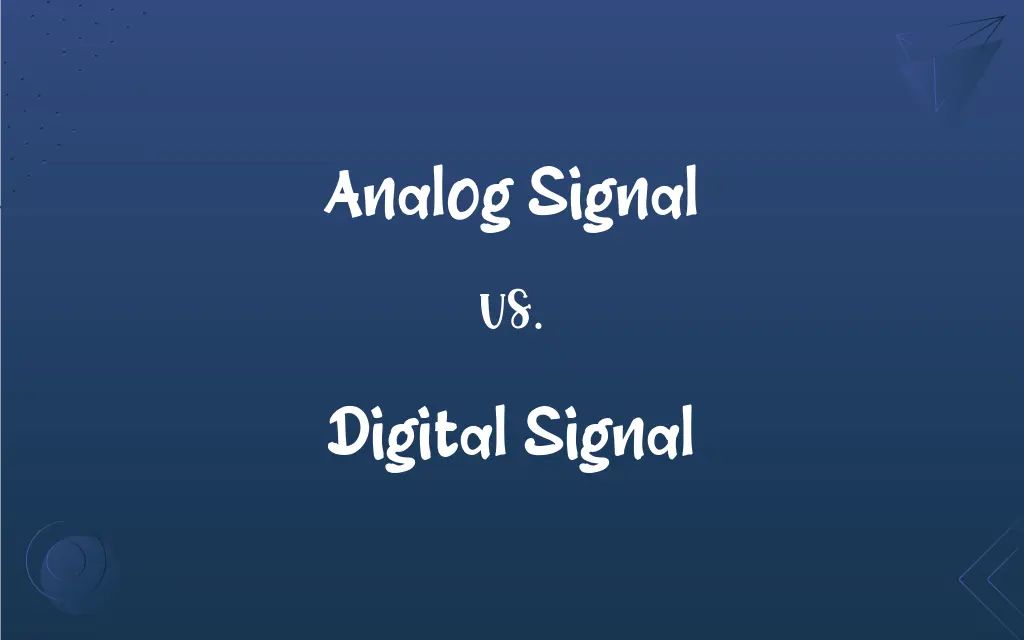Analog Signal vs. Digital Signal: What's the Difference?
Edited by Janet White || By Harlon Moss || Updated on October 11, 2023
Analog signal represents continuous waves, conveying information through amplitude, phase, and frequency variation, while a digital signal represents information using discrete values (often 0 and 1).

Key Differences
Analog signals embody continuously variable signals, which are often representative of physical measurements or different types of waveforms. Digital signals, on the other hand, convey information through a series of discrete values, typically in binary form, showcasing a clear-cut representation of data.
Analog signals can carry a vast range of values, which means they can represent numerous different phases, amplitudes, and frequencies within a singular signal, demonstrating a high degree of variability and complexity. Conversely, digital signals restrict their representation to distinct steps or values, fundamentally zeros and ones, offering clarity and reproducibility but at the expense of that infinite variability.
When considering noise and distortion, analog signals can become quite susceptible, with disturbances potentially altering the quality and precision of the transmitted information. Digital signals, in contrast, exhibit a robust nature against disturbances due to their discrete nature, maintaining integrity even amidst interference, as long as the disturbance does not alter the discrete values beyond recognition.
In the technological context, analog signals often find usage in traditional broadcasting mediums and telecommunications, facilitating the transmission of data in its raw, continuous form. Digital signals, owing to their stability and ease of reproduction, have become predominant in computing and digital communication, owing to their robustness against errors and capability to preserve data fidelity.
Analog signals, given their continual form, offer a more accurate representation of sound waves, which is why they are frequently associated with high-fidelity audio and broadcasting. Meanwhile, digital signals, through their precise, clear-cut values, ensure consistency and uniformity in data transmission and processing, enabling widespread application in various digital technologies and data storage.
ADVERTISEMENT
Comparison Chart
Representation
Continuous wave
Discrete values
Value Range
Infinite
Limited (e.g., 0,1)
Noise Susceptibility
High
Low
Application in Technologies
Traditional
Modern
Data Fidelity and Reproduction
Can degrade
Preserved
ADVERTISEMENT
Analog Signal and Digital Signal Definitions
Analog Signal
Analog signals are capable of depicting physical phenomena in a format that mirrors the original source.
Vinyl records use grooves to directly correlate to sound waves, creating an analog signal.
Digital Signal
Digital signals demonstrate a resilience to noise and distortion during transmission and replication.
In digital broadcasting, even with minor interference, the clarity of audio and video is usually maintained.
Analog Signal
Analog signals often encounter challenges in maintaining integrity over long-distance transmission due to susceptibility to noise.
An AM radio broadcast may experience static (noise) which subtly alters the analog signal being received.
Digital Signal
Digital signals utilize discrete values, typically zeros and ones, to convey information.
In digital clocks, time changes are indicated by distinct, non-continuous numerical jumps.
Analog Signal
Analog signals exhibit continuous variability, representing information through variable waveforms.
The needle on a speedometer moves smoothly across a continuum of speeds, portraying an analog signal.
Digital Signal
Digital signals enable exact replication and storage without quality degradation over numerous copies.
When duplicating a digital file, each copy is identical to the original without any loss of quality.
Analog Signal
Analog signals, by conveying a smooth, continuous waveform, can provide a highly accurate representation of the original data, particularly in audio and visual formats.
The vibrations of a violin string are translated into electrical currents with varying amplitude in an analog signal for amplification.
Digital Signal
Digital signals can be encrypted and securely transmitted, safeguarding the information against unauthorized access.
Online banking utilizes digital signals that are encrypted to protect sensitive financial information during transmission.
Analog Signal
Analog signals can represent an infinite range of values within specified minimum and maximum limits.
The various shades of sunset can be translated into an infinite spectrum of values in an analog signal.
Digital Signal
Digital signals find pervasive usage in computing and data storage due to their discrete and stable nature.
Hard drives store data in the form of digital signals, using bits (0s and 1s) to encode information.
FAQs
What is a digital signal?
A digital signal uses discrete values, commonly binary form (0 and 1), to represent information.
Why are analog signals susceptible to noise?
Analog signals are susceptible because any small disturbance can alter the continuous waveform.
Can analog signals be converted to digital?
Yes, analog signals can be converted to digital using an Analog-to-Digital Converter (ADC).
How does analog signal transmission work?
Analog signals are transmitted by varying some aspect of the signal, such as amplitude or frequency, in continuous waveforms.
What is an analog signal?
An analog signal is a continuous waveform that can represent an infinite range of values.
How do analog and digital signals differ in data representation?
Analog signals represent data through continuous waveforms, while digital signals use discrete steps/values.
Are digital signals always binary?
While binary (0 and 1) is most common, digital signals can utilize other discrete numbering systems.
Why do digital signals dominate modern communication technologies?
Digital signals are favored for their error-resistance, ease of replication, and compatibility with digital systems.
How is sound represented in a digital format?
Digital sound is represented using binary code, mapping the sound into discrete values.
What is "sampling" in the context of converting analog to digital signals?
Sampling involves measuring the amplitude of an analog signal at uniform intervals to convert it to digital form.
Does the conversion of analog to digital signals involve data loss?
Yes, conversion can involve data loss, as continuous analog waveforms are mapped to discrete digital values.
Is it possible to convert digital signals to analog?
Yes, using a Digital-to-Analog Converter (DAC), digital signals can be transformed into analog.
Where are analog signals commonly used?
Analog signals are frequently used in audio recording, radio broadcasting, and certain communication systems.
What are the typical applications of digital signals?
Digital signals are widely utilized in computers, digital communication, and data storage and retrieval systems.
Which signal type is preferred for long-distance communication?
Digital signals are generally preferred due to their resistance to noise and ability to maintain data integrity.
Can analog and digital signals coexist in a system?
Yes, many systems utilize both analog and digital signals, converting between them as needed.
Why might some audio enthusiasts prefer analog signals?
Some prefer analog for its ability to accurately replicate sound waves, often considered richer or warmer.
How is sound recorded in an analog format?
Analog sound recording captures continuous waveforms directly, such as in the grooves of a vinyl record.
How is a digital signal transmitted?
Digital signals are transmitted by sending sequences of discrete values, typically in a binary format.
Are digital signals immune to noise?
Digital signals are not immune but are highly resistant to noise due to their discrete nature.
About Author
Written by
Harlon MossHarlon is a seasoned quality moderator and accomplished content writer for Difference Wiki. An alumnus of the prestigious University of California, he earned his degree in Computer Science. Leveraging his academic background, Harlon brings a meticulous and informed perspective to his work, ensuring content accuracy and excellence.
Edited by
Janet WhiteJanet White has been an esteemed writer and blogger for Difference Wiki. Holding a Master's degree in Science and Medical Journalism from the prestigious Boston University, she has consistently demonstrated her expertise and passion for her field. When she's not immersed in her work, Janet relishes her time exercising, delving into a good book, and cherishing moments with friends and family.
































































